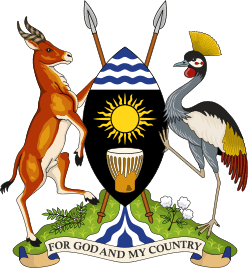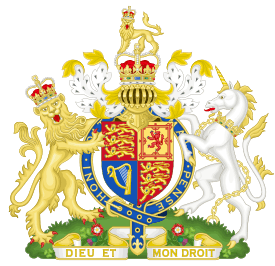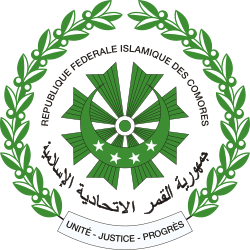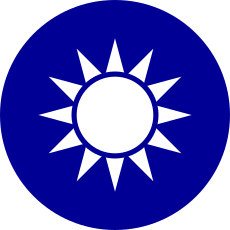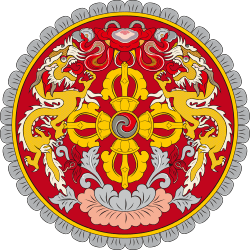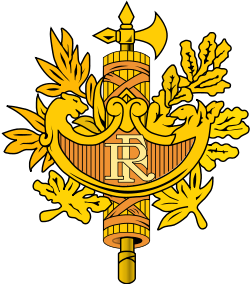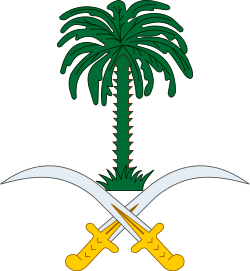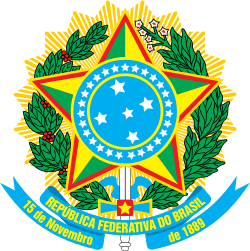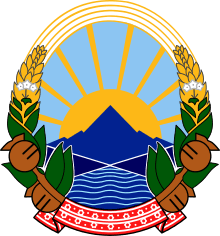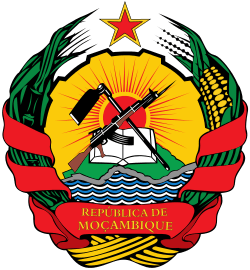National coat of arms
National coat of arms is a symbol which denotes an independent state in the form of a heraldic achievement.[1] While a national flag usually is being used by common people and is flown outside and on ships, the national coat of arms is normally seen as the symbol of the government or in monarchies even rather for the head of state personally and used in print and on porcelain and as wall decorations in parliamentary buildings. The royal arms of a monarchy, which sometimes is identical to the national arms, is sometimes described as arms of dominion or arms of sovereignty.[2]
An important use for national coats of arms is as the main symbol on the cover of passports, the document used internationally to prove the citizenship of a person.
For a symbol to be called national coat of arms, it should follow the rules of heraldry. If it does not, it is not formally a coat of arms but still a national emblem. However, many unheraldic national emblems are colloquially called national coats of arms anyway because they are used for the same purposes as national coats of arms.[3]
Types of national coats of arms
Heraldic achievements

The original national coats of arms are heraldic arms, which has a shield with symbols (charges) upon it and often symbols like a crown on top of the shield, supporters etc. In the real sense of the word, these national coats of arms are the only ones which should be called coats of arms, since that term reflects that the emblem used is following the rules of heraldry.[3] Heraldry originated in Western Europe and has now spread to all parts of the world.
The heraldic coat of arms also have differences in between themselves. Up until the 20th century most independent nations in the civilized world were monarchies and therefore used the monarchistic style of coat of arms. This style is illustrated below by the Swedish greater coat of arms, which is still used as coat of arms by the Kingdom of Sweden. Characteristic for this style of coat of arms is the crown on top of the ermine mantling with the coat of arms of both the kingdom and the Monarch within. In Sweden's case the inner coat of arms is upheld by two lions and encircled by the chain of the Order of the Seraphim. This is an often used style by the European kingdoms. Lions is used in all coat of arms of the European kingdoms. The lion is a symbol of power and sovereignty but also a symbol of Jesus as the Lion of Judah.
The style of the coat of arms of the European republics are diverse. Many republics have chosen to use the same, or a modified version, of coat of arms as they used as monarchies or as part of monarchies. Finland uses the coat of arms that before the independence where used as coat of arms of the Grand-duke of Finland, a title held by the Swedish Monarch until 1809. Russia uses the same coat of arms as the former Russian Empire, but without the ermine mantling and crown.
Many of the former European colonies have chosen to use a heraldic coat of arms, but with no connection to the coat of arms used by the colonizing empires. Australia and Jamaica are examples of countries that have created a modern coat of arms but according to old heraldic principles. These two nations also have chosen not to use a crown in their coat of arms although they formally are monarchies. The coat of arms of Uganda below is a typical example of an African coat of arms, with a tribal shield surrounded by native animals.
National seal

Another common type of national coats of arms is the seal. This is common in the Americas but also around the world. The round form with text saying what it stands for is easy to recognise.
Many national seals are actually, to some extent, in part heraldic and can even have set colours which are always used, even if a seal has another use originally - as a stamp in wax - and in this sense formally never has colours.
-
.svg.png)
Great Seal of the United States, has the national coat of arms as part of the seal
National emblems of the East Asian tradition
The Japanese equivalent to a heraldic coat of arms is the mon (jap. 紋, "sign" or "emblem"), which in its used can be compared to heraldry of the Western world. Similar symbols is common throughout East Asia.
National emblem
An emblem which is not following the rules of heraldry but which fulfills the same use as a national coat of arms might do, can be called a national emblem. These are often used by countries, whose regimes are or once were revolutionary and therefore did not want to use ordinary heraldry.
Socialist state emblems

Many countries which came under the influence of the Soviet Union during the 20th Century, took after the design of the State Emblem of the Soviet Union, created in the 1920s. The forms followed a very common pattern and since these national emblems were used in the same way as traditional heraldic coats of arms, even if they did not at all follow the rules of heraldry, the common designs have been called "socialist heraldry". Many of them incorporated symbols of industry and agriculture, the hammer and sickle, a raising sun and the red star of communism, and it was not uncommon to show landscapes and weapons, as can be seen in the examples below. When giving up communism, most of these countries returned to traditional heraldry, see for instance the coat of arms of Bulgaria, coat of arms of Georgia, coat of arms of Hungary, and coat of arms of Romania.
The designs of socialist heraldry also influenced some non-socialist states, like Italy.[3]
See also
References
- ↑ Oswald, Gert (1984). "Staatswappen". Lexikon der Heraldik (in German). Mannheim/Vienna/Zurich: Bibliographisches Institut. p. 375. ISBN 3-411-02149-7.
- ↑ Friar, Stephen, ed. (1987). A New Dictionary of Heraldry. London: Alphabooks/A&C Black. p. 27. ISBN 0 906670 44 6.
- 1 2 3 von Volborth, Carl-Alexander (1983). Heraldry: Customs, Rules and Styles. Ware, Hertfordshire: Omega Books Ltd. p. 11. ISBN 0-907853-47-1.
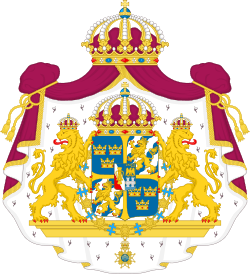



_of_Iraq_2008.svg.png)

.svg.png)

